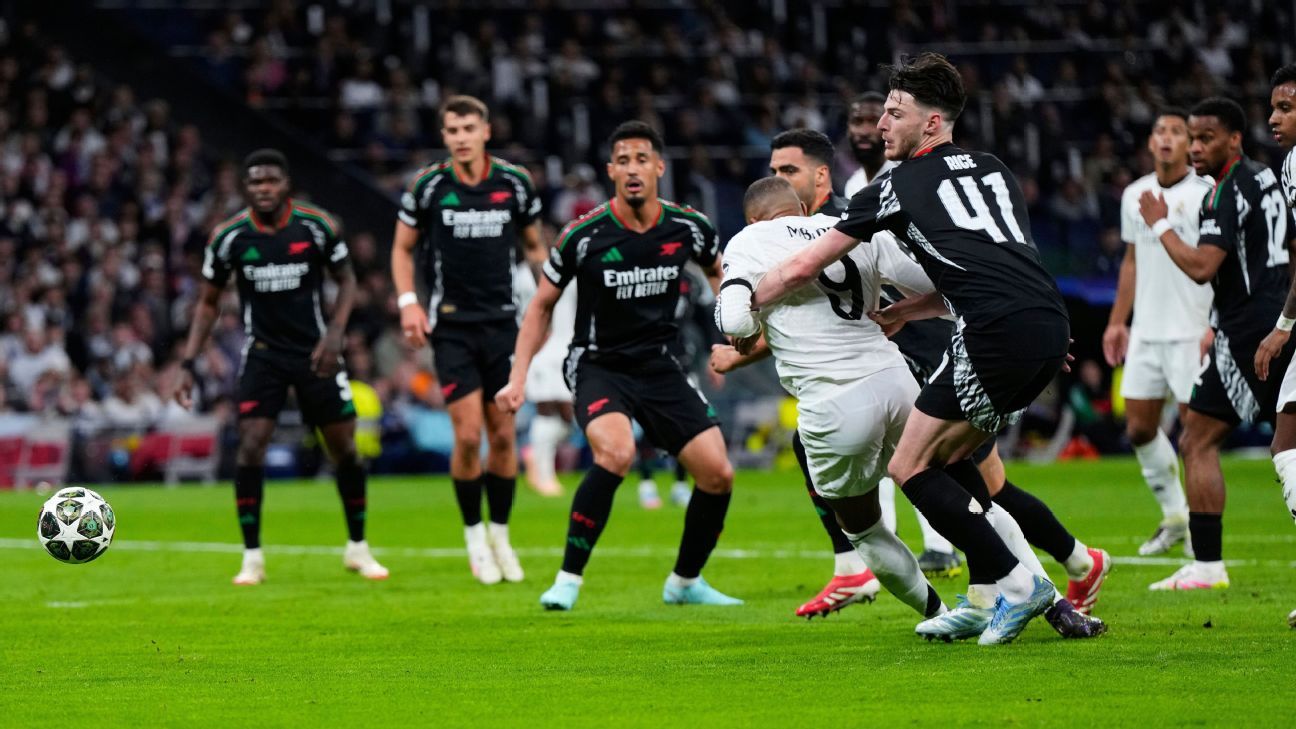The VAR Review: Why Mbappé’s penalty was overturned vs Arsenal
Dale Johnson analyses the VAR decision to overturn Real Madrid’s penalty vs. Arsenal in the Champions League. (1:10)
The Video Assistant Referee took centre stage again on Wednesday night, as Arsenal were awarded a penalty and Real Madrid controversially had a spot kick taken away in the second leg of their UEFA Champions League quarterfinal.
Arsenal won 2-1 on the night, and 5-1 on aggregate.
There were similarities between the incidents, so why did the VAR get involved, and why were there opposing conclusions? And why did cancelling Madrid’s penalty take so long?
Possible penalty: challenge on Merino
What happened: Arsenal had a corner in the ninth minute. As Declan Rice‘s delivery was played toward goalkeeper Thibaut Courtois, Arsenal midfielder Mikel Merino went to ground under pressure from Raúl Asencio. Referee François Letexier allowed play to continue, but shortly afterward he was told to go to the monitor to check a possible penalty by the VAR, Jérôme Brisard.
VAR decision: Penalty, Bukayo Saka‘s effort saved by Courtois.
VAR review: When does holding onto an opponent become a foul? That in itself isn’t considered an offence; it’s the impact upon the opponent that’s key. In Monday’s VAR review, we discussed how judging that impact is difficult for the video assistant referee.
Usually, the flight of the ball is important for a VAR review — if a player who was being held would have had the ability to challenge for the ball, it’s more likely the VAR will intervene for a spot kick. If the attacker isn’t running into the dropping zone, the VAR is usually looking for a clear non-footballing action.
Asencio was holding Merino, but was there enough impact for this to result in a penalty through a VAR review?
It was a soft call, and a quick one too taking just over two minutes. If that was a swift process, what was soon to follow certainly wasn’t.
Possible penalty overturn: Rice challenge on Mbappé
What happened: Real Madrid were pushing forward in the 23rd minute. Lucas Vázquez played the ball forward, which was nodded on by Asencio. As Kylian Mbappé turned to move onto the ball, he went to ground claiming he was being held by Rice.
Referee Letexier immediately pointed to the spot and showed the yellow card to Rice, ruling him out of a potential semifinal, first leg. It was checked by the VAR.
VAR decision: Penalty cancelled.
VAR review: Real Madrid fans will wonder how a penalty can be awarded to Arsenal, but their own cancelled in what would seem to be similar situations. If the VAR intervenes to give one soft penalty, why is he intervening to cancel another?
Rice had his arm around Mbappe, and we’ve become accustomed to evidence of contact leading to a referee’s decision being upheld. That said, upper body contact is judged slightly differently to contact with the lower body. It means contact with a tackle is likely to be upheld, but with holding the impact is more important.
It’s clear the France international wasn’t held enough to go to ground in the way he did. It was a refreshing surprise that the VAR did get involved.
The worst thing was the time it took — exactly five minutes from the award of the penalty to the referee leaving the monitor and signalling that it had been overturned. It was way too long.
Rice’s yellow card was cancelled, meaning he is available to face Paris Saint-Germain in two weeks.
The process only added to the confusion, too, with the television graphic incorrectly showing that the penalty had been chalked off for offside. While the referee would have been sent to the monitor to assess a potential offside against Mbappé, play restarted with a dropped ball to Arsenal goalkeeper David Raya. Had it been for offside, the Gunners would have received an indirect free kick.
Premier League referees had come in for criticism for the length of reviews in such situations. Now, once it’s been decided the referee should go to the monitor the attacking phase is checked while he runs over. But in this game, the referee, the players and the supporters were left standing and waiting not only the foul, but the offside was checked too.
That the referee would have had to go to the monitor for the offside anyway, it makes little sense he wasn’t told to go over while they checked the offside. UEFA’s semi-automated offside technology should have made it quicker, too.




